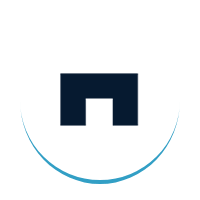7 Best Custom Software Development Companies for 2026
Navigating the crowded market of technology partners to find the right fit for your project can be a significant challenge. Whether you’re a startup needing a rapid MVP, an enterprise aiming for AI-driven transformation, or a CTO looking to augment your team, selecting from the best custom software development companies is a critical decision that impacts your timeline, budget, and final product quality. A foundational step in this process involves asking yourself the critical question of whether to build or buy software. Once you’ve committed to building, the next step is finding the right team.
This guide is designed to simplify that search. We’ve compiled a comprehensive list of the top platforms and firms where you can find and vet your ideal technology partner. From specialized agencies offering end-to-end custom software development to marketplaces connecting you with elite freelance talent, we cover the spectrum of available options.
Each entry provides a detailed profile covering core services, ideal use cases, pricing structures, and highlights from their work. We’ll delve into how these companies leverage technologies like AI and provide robust business intelligence services to deliver impactful results. You’ll find direct links and practical insights to help you make an informed decision, ensuring you partner with a company that aligns perfectly with your technical needs and business objectives. Let’s explore the leading contenders who can help you build the software that powers your growth.
7 Best Custom Software Development Companies
1. Bridge Global
Bridge Global stands out in the crowded market of custom software development companies by positioning itself as an AI-first technology partner. Instead of treating artificial intelligence as a separate service, Bridge Global integrates it across the entire software development lifecycle (SDLC). This unique approach is designed to deliver faster, more predictable, and higher-quality digital products for a diverse range of clients, from agile startups to established enterprises.
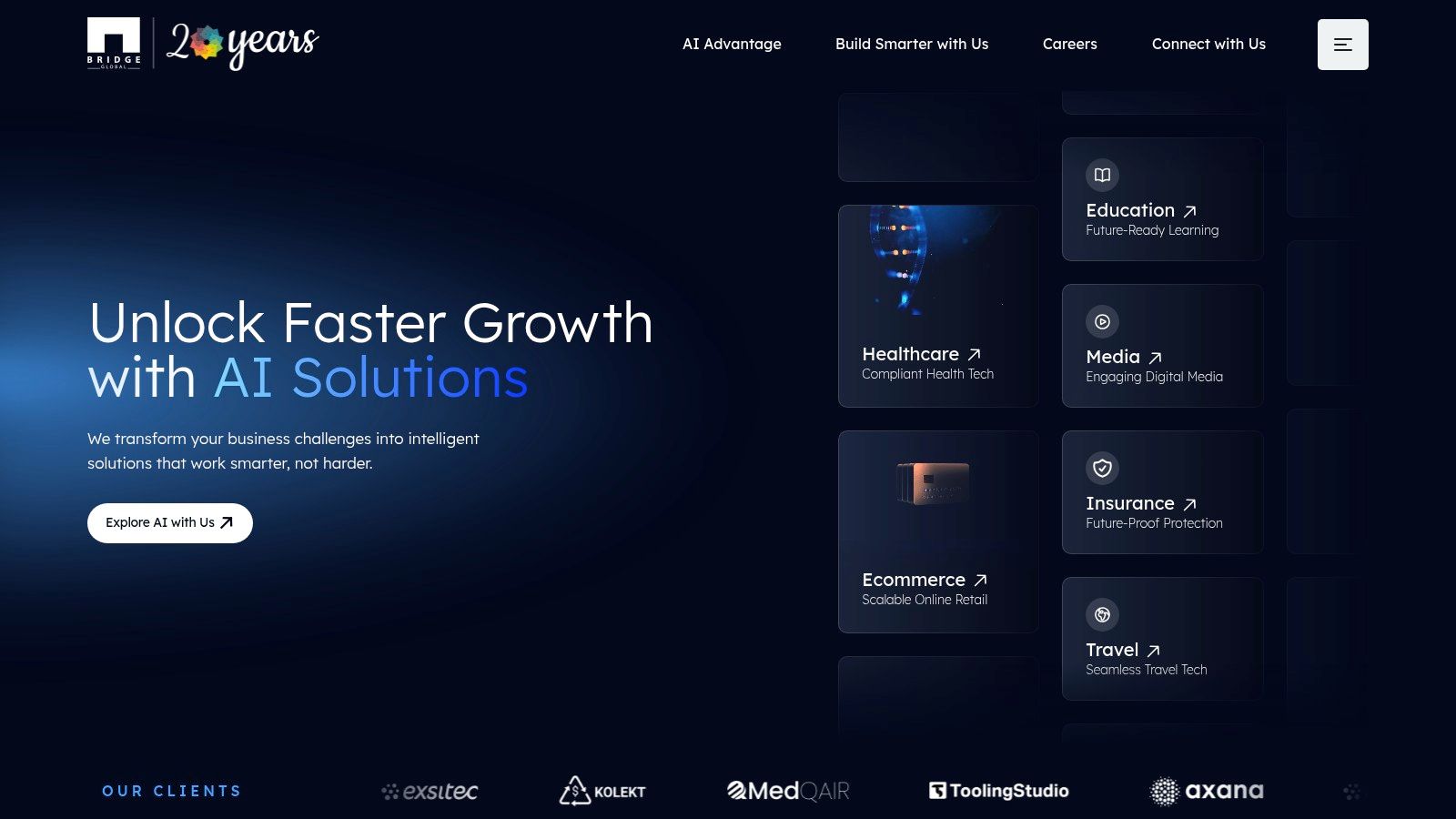
With over two decades of experience, the company has refined a methodology that combines strategic AI discovery with agile execution. Their end-to-end service model guides businesses from initial idea validation and MVP development to full-scale product engineering and operational modernization, making them a comprehensive AI solutions partner. This process, as we explored in our AI adoption guide, ensures that AI is not just a feature but a core driver of business value.
Core Strengths and Service Offerings
Bridge Global’s key differentiator is its practical application of AI to solve real-world development challenges. This translates into tangible benefits like automated workflows, predictive risk analysis, and significantly improved code and quality assurance standards. Their structured approach ensures technology not only meets but anticipates business needs.
Their comprehensive service portfolio includes:
- AI-Integrated Development: Embedding AI tools for enhanced code generation, automated testing, and early bug detection. Their AI development services focus on building intelligent systems that drive measurable business outcomes.
- End-to-End Product Engineering: A holistic process covering everything from AI Discovery Workshops to deploying and supporting production-ready software. This includes robust custom software development and specialized SaaS consulting.
- Cross-Functional Offshore Teams: Providing dedicated, skilled teams that act as a seamless extension of your in-house talent, ensuring strong communication and deep technical expertise.
- Industry-Specific Solutions: Bridge has proven expertise in regulated and complex sectors, including delivering compliant healthcare software development, scalable ecommerce platforms, and secure fintech solutions.
Why Bridge Global is a Top Choice
Bridge excels in forming long-term, collaborative partnerships. Their client cases frequently highlight their exceptional communication, technical depth, and commitment to client success. Partners like MedQAIR and Tooling Studio praise Bridge Global for turning complex requirements into functional, high-performing software. This proven track record makes them one of the best custom software development companies for organizations seeking a reliable and innovative technology ally.
Their flexible engagement models, including workshops, dedicated teams, and full project builds, allow clients to choose the structure that best fits their budget and goals. This adaptability, combined with deep expertise in cloud services and business intelligence services, ensures they can support digital transformation at any scale.
Key Information & Considerations
| Feature | Details |
|---|---|
| Primary Focus | AI-integrated custom software development, offshore team augmentation, end-to-end product engineering. |
| Key Differentiator | Proactive integration of AI across the entire SDLC to improve speed, quality, and predictability. |
| Engagement Models | Flexible options including dedicated offshore teams, project-based development, and strategic workshops. |
| Industry Expertise | Healthcare (compliant solutions), Ecommerce, Finance, Insurance, Education, Media, Construction, and more. |
| Pros | AI-driven risk reduction and quality improvement, strong client testimonials on communication and technical skill, comprehensive service from strategy to support. |
| Cons | Pricing is not public and requires direct consultation; clients with low data maturity may need preparatory work to fully leverage their ai development services. |
For businesses looking to not just build software but to build it smarter, faster, and with a clear competitive edge, Bridge Global offers a compelling, future-focused partnership.
Website: https://www.bridge-global.com
2. Clutch
Clutch is not a development company itself, but rather an essential B2B research, ratings, and reviews platform. For any CTO, product leader, or founder seeking to find the best custom software development companies, it is an indispensable first stop. The platform provides a meticulously organized directory where businesses can discover and vet potential partners for projects ranging from mobile app development to enterprise-level AI development services.
What makes Clutch so powerful is its data-driven approach. It goes beyond simple listings by providing verified, in-depth client reviews, detailed service breakdowns, and portfolio examples. This transparency helps decision-makers build confidence before ever making initial contact.
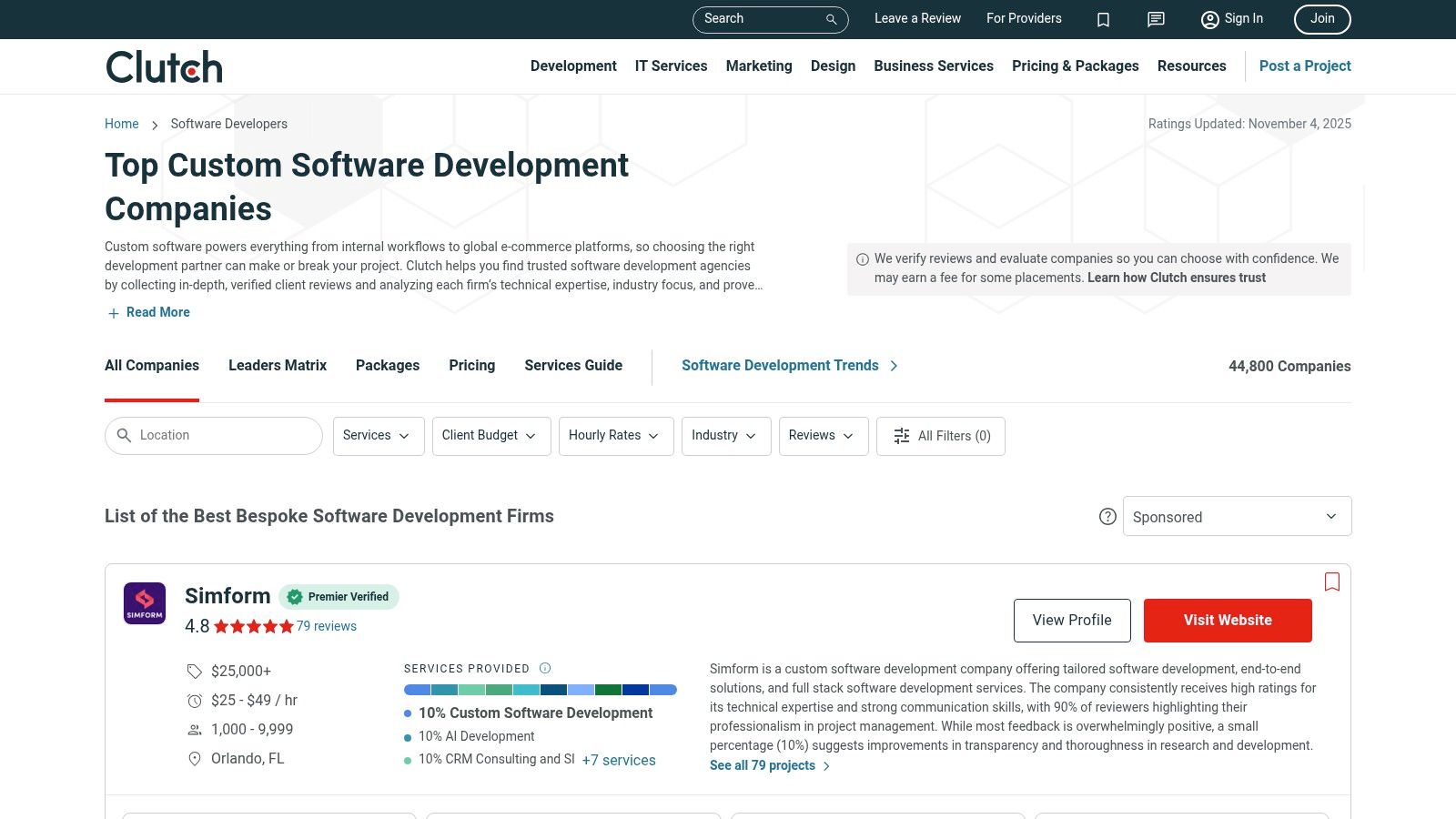
Why It Stands Out
Clutch excels with its highly granular filtering system and its proprietary Leaders Matrix. You can drill down to find a partner that precisely matches your needs, filtering by location, hourly rate, project size, team size, and specific technology stack (e.g., Python, React Native, AWS).
The Leaders Matrix is a quadrant-style graph that maps out top-performing firms based on their “Ability to Deliver” and “Focus” in a specific service area. This visual tool offers a quick, at-a-glance understanding of the market leaders, making it easier to shortlist top-tier candidates for your custom software development project.
How to Use Clutch Effectively
To get the most out of Clutch, follow these practical steps:
- Define Your Criteria First: Before you start searching, know your budget, required tech stack, and project scope. This will make your filtering much more efficient.
- Use Multiple Filters: Combine filters for location, budget, and services to narrow the field significantly. For example, search for “US-based firms under $100/hour specializing in healthcare software development.”
- Read the Reviews in Detail: Don’t just look at the star rating. Read the full-length, verified reviews to understand the client’s experience, the project’s challenges, and the vendor’s communication style. The quality of these reviews is a key differentiator, and you can see a variety of successful client cases that demonstrate a firm’s capabilities.
- Check Company Profiles: Look at the “Service Focus” percentage on each profile. A company with 70% of its focus on AI is likely a better specialist than one with only 10%.
Pros and Cons
| Pros | Cons |
|---|---|
| Granular Search Filters: Unmatched ability to narrow down vendors by industry, technology, budget, and location. | Sponsored Placements: Top search results can be influenced by paid sponsorships, so be sure to evaluate all options. |
| Verified, In-Depth Reviews: Transparent and detailed feedback from real clients helps build trust and validate a firm’s claims. | No Unified Contracting: Clutch is a directory, not a marketplace. You must negotiate terms and contracts directly with each vendor. |
| Leaders Matrix: Provides a clear visual ranking of the top companies in any given service category. | Information Overload: The sheer volume of data can be overwhelming for new users. |
Website: https://clutch.co/developers
3. Upwork
Upwork is one of the world’s largest freelance marketplaces, connecting businesses with a massive global pool of independent professionals and boutique agencies. While not a traditional development company, it serves as a powerful platform for businesses looking to hire individual software developers or small, agile teams for custom projects. It is particularly effective for flexible, milestone-based contracts or hourly engagements, enabling rapid team augmentation and specialized skill acquisition.
The platform’s strength lies in its comprehensive ecosystem, which includes verified work histories, detailed client reviews, and a tiered talent system with “Top Rated” badges. This data helps companies vet candidates with greater confidence. Upwork also provides built-in tools for project management, including time tracking and payment protection through escrow services, which simplifies the administrative burden of managing freelance talent.
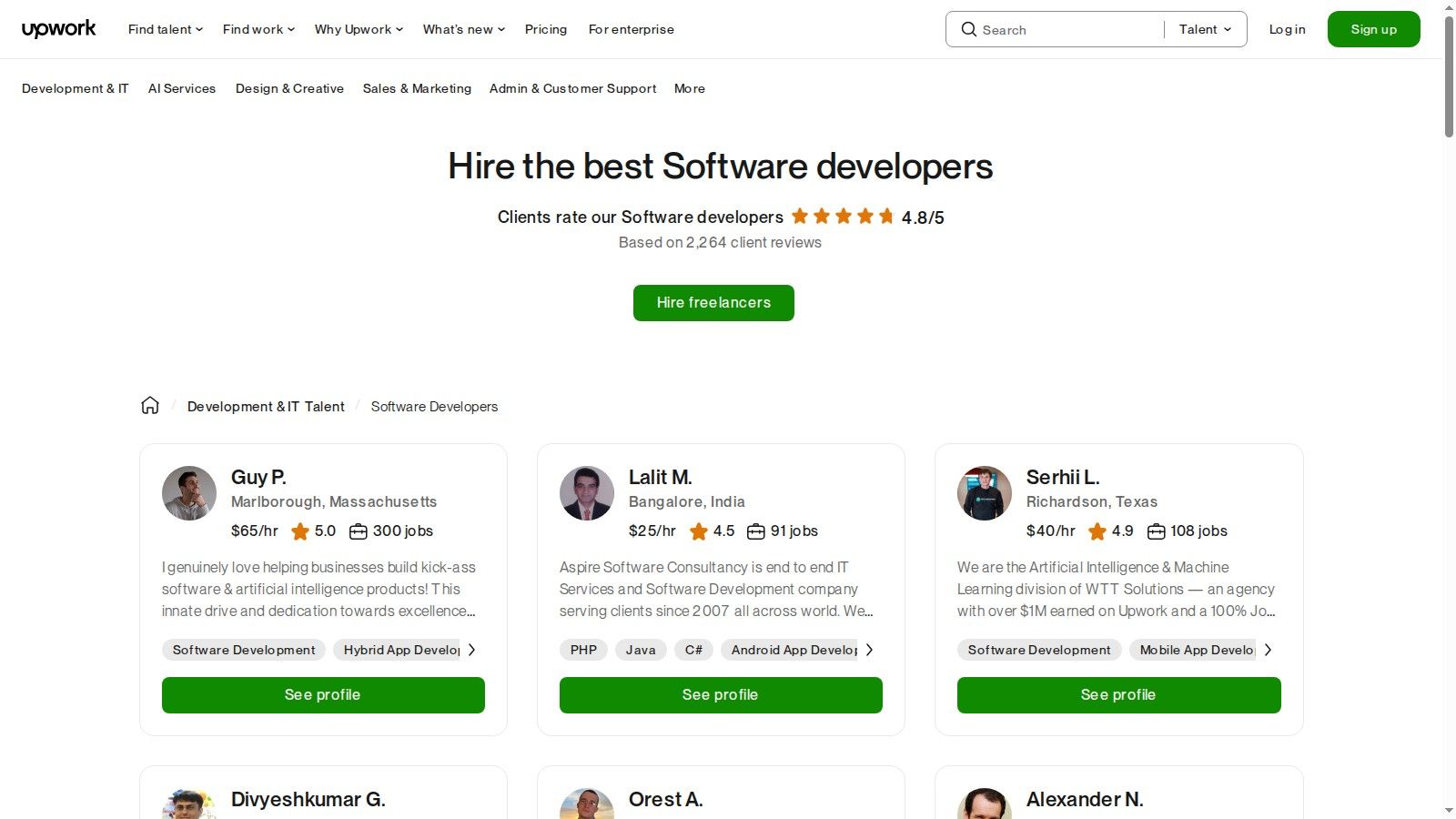
Why It Stands Out
Upwork excels at providing unparalleled access to a diverse, global talent pool at nearly every price point. Unlike traditional recruitment, which can take weeks or months, businesses can post a job and receive proposals from qualified developers within hours. This speed and flexibility make it an ideal solution for startups needing to build an MVP quickly or enterprises looking to fill a niche skill gap without a long-term commitment.
Its integrated platform features streamline the entire hiring and project execution lifecycle. From an AI-assisted job post generator that helps you write effective descriptions to secure payment systems, Upwork reduces the friction often associated with hiring external contractors. The Business Plus plan further enhances this by offering access to pre-vetted talent and consolidated invoicing for eligible US companies. If you’re looking to understand the intricacies of building your team, you can explore resources that detail the process to hire dedicated developers.
How to Use Upwork Effectively
To maximize your success on the platform, follow these best practices:
- Write a Hyper-Specific Job Post: Clearly define your project scope, required technical skills (e.g., Node.js, AWS, React), experience level, and expected deliverables. The more detail you provide, the better the quality of applicants.
- Vet Candidates Thoroughly: Look beyond the proposal. Scrutinize a developer’s work history, portfolio, client feedback, and Job Success Score. Conduct video interviews to assess communication skills and cultural fit.
- Start with a Small, Paid Test Project: Before committing to a large-scale project, hire your top candidate for a small, well-defined task. This is a low-risk way to evaluate their technical abilities, responsiveness, and work quality.
- Leverage Platform Tools: Use the built-in time tracker for hourly projects to verify work and the escrow system for fixed-price milestones to ensure you only pay for completed and approved work.
Pros and Cons
| Pros | Cons |
|---|---|
| Vast Talent Pool: Access to a huge selection of developers with diverse skills and experience at varied price points ($20–$150+/hour). | Hands-On Management: You are responsible for vetting, interviewing, and managing the talent unless you pay for higher-tier service plans. |
| Integrated Platform: Built-in contracts, time tracking, and escrow for fixed-price projects simplify payments and project administration. | Service Fees: Client-side fees apply, typically 5% on the basic plan, with different rate structures for other plans. |
| Flexibility and Speed: Quickly staff projects with hourly or milestone-based contracts, avoiding long-term overhead. | Quality Varies: The quality of talent can be inconsistent, requiring a diligent screening process to find top performers. |
Website: https://www.upwork.com/hire/software-developers/
4. Toptal
Toptal positions itself as an exclusive network of the top 3% of freelance talent, connecting businesses with elite software developers, designers, finance experts, and project managers. Unlike open marketplaces, Toptal offers a curated, high-touch experience ideal for organizations that need to quickly onboard proven experts for mission-critical projects. This makes it a go-to platform for companies seeking the best custom software development companies and individual talent without the overhead of a traditional agency.
The platform’s core value lies in its rigorous, multi-stage screening process. This ensures that every developer in the network has been thoroughly vetted for technical expertise, professionalism, and communication skills. For businesses, this significantly reduces the time, cost, and risk associated with technical hiring, allowing them to scale their teams with confidence.

Why It Stands Out
Toptal’s key differentiator is its combination of speed, quality, and flexibility. The platform’s matching experts hand-select candidates for your specific needs, often presenting a shortlist within 24 to 48 hours. This white-glove service saves internal teams countless hours of sourcing and vetting.
Furthermore, Toptal’s risk-free trial period is a standout feature. Clients can work with a developer for up to two weeks, and if they are not completely satisfied, they won’t be charged. This “pay only if satisfied” model demonstrates Toptal’s confidence in its talent pool and provides unparalleled peace of mind for companies undertaking a new custom software development project.
How to Use Toptal Effectively
To maximize your experience with Toptal, consider these steps:
- Prepare a Detailed Job Description: Be as specific as possible about the required technical skills, project goals, team dynamics, and expected duration. The more detail you provide, the better and faster the matching process will be.
- Leverage the Matching Team: Communicate openly with the Toptal expert who assists you. They understand the talent network deeply and can provide valuable insights to refine your requirements and identify the perfect fit.
- Utilize the Trial Period: Treat the initial two weeks as a genuine trial. Fully integrate the new developer into your team, assign them a meaningful task, and evaluate their technical skills, communication, and cultural fit. Provide clear feedback early on.
- Plan for Premium Rates: Understand that Toptal provides elite talent. While rates are not public, expect them to be at the higher end of the market, reflecting the quality and experience of the developers.
Pros and Cons
| Pros | Cons |
|---|---|
| Elite, Vetted Talent: Access to the top 3% of global freelance developers, ensuring a high quality bar. | Premium Cost: Rates are higher than on other freelance platforms, reflecting the caliber of the talent. |
| Rapid Matching Process: Hand-selected candidates are typically presented within 24–48 hours, accelerating hiring. | Limited Availability: For highly niche or specialized tech stacks, the pool of available talent may be smaller. |
| Risk-Free Trial: A two-week trial period allows you to evaluate a candidate before committing financially. | No Public Pricing: You must engage with Toptal to get a quote, as rates are not listed on the website. |
Website: https://www.toptal.com/
5. Fiverr (Fiverr Pro available)
Fiverr is a massive global marketplace that connects businesses with freelancers for a vast range of digital services, including software development. While known for smaller, task-based “gigs,” its platform has evolved to support larger, more complex projects, making it a viable option for businesses looking for best custom software development companies on a project basis. It is particularly effective for startups needing an MVP, small businesses requiring a specific website feature, or teams needing a discrete software module built quickly.
What sets Fiverr apart is its gig-based, productized service model. Developers package their offerings with clear deliverables, timelines, and upfront pricing. This transparency removes the ambiguity common in traditional quoting processes and allows businesses to find and purchase development services with the ease of an e-commerce transaction. The “Fiverr Pro” tier adds a layer of confidence by offering access to hand-vetted, top-tier developers.
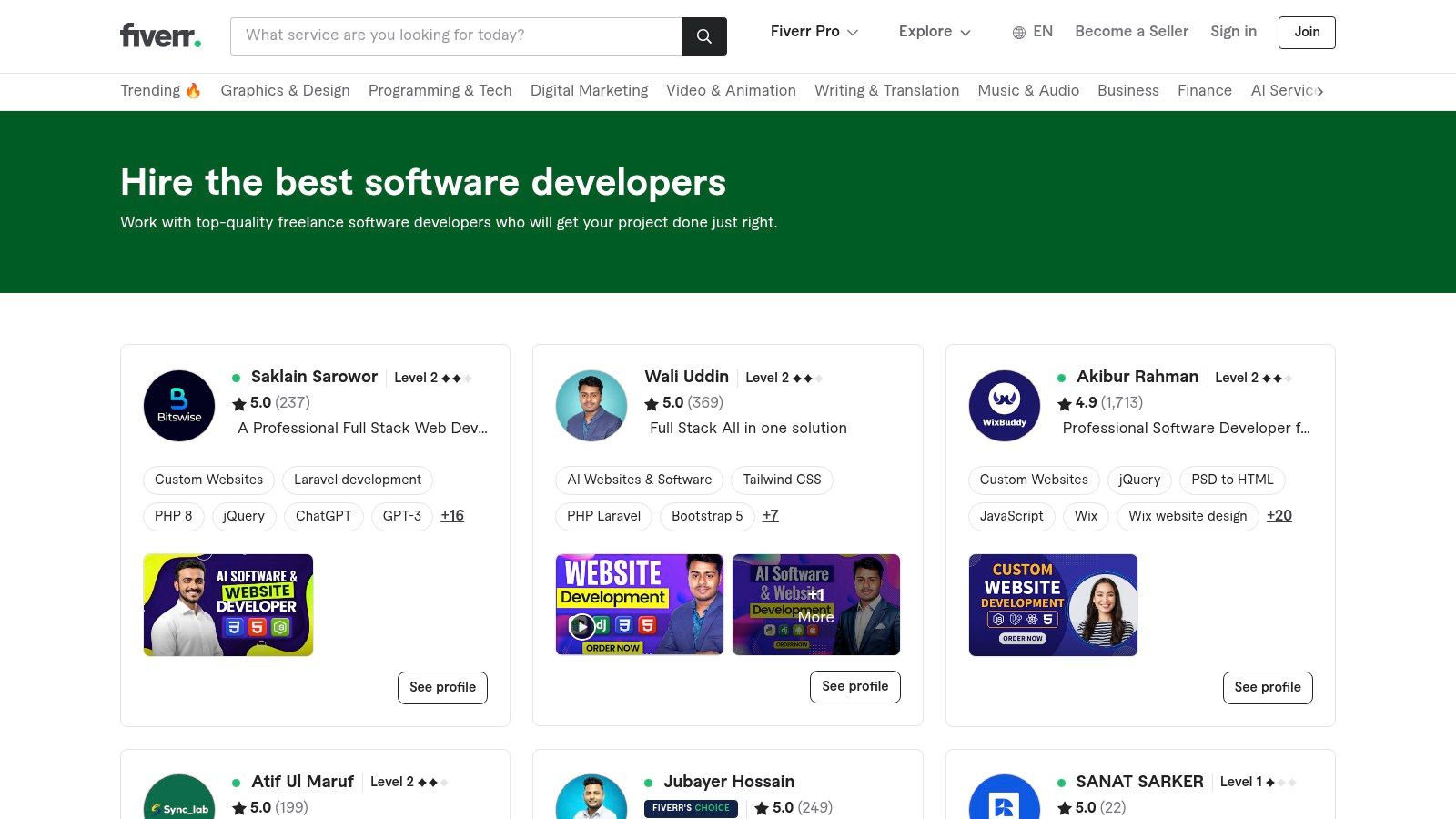
Why It Stands Out
Fiverr excels at providing speed, transparency, and access to a global talent pool. Unlike traditional firms that require lengthy consultation and proposal phases, Fiverr allows you to purchase a defined custom software development package in minutes. The upfront pricing and delivery estimates on every gig page eliminate budget uncertainty.
The Fiverr Pro service is a significant differentiator. Pro developers undergo a rigorous vetting process, ensuring they possess high-level expertise, a proven track record, and strong communication skills. This curated experience provides a safety net and quality assurance that is often missing in open freelancer marketplaces, making it a reliable choice for critical projects.
How to Use Fiverr Effectively
To get the most out of Fiverr for your software needs, follow these steps:
- Start with Fiverr Pro: For any serious business project, begin your search within the Pro category to ensure you are engaging with top-vetted professionals.
- Submit a Detailed Brief: Use Fiverr’s “Get a Quote” feature. Provide a clear and comprehensive project brief outlining your goals, required tech stack, and desired outcomes. This allows qualified developers to send you custom offers tailored to your needs.
- Review Portfolios and Past Work: Don’t just rely on ratings. Scrutinize the developer’s portfolio to see if their past projects align with your vision and quality standards. Look for client cases that demonstrate relevant experience.
- Communicate Before Ordering: Always contact potential developers before placing an order. Use this conversation to assess their understanding of your project, their communication style, and their technical approach.
Pros and Cons
| Pros | Cons |
|---|---|
| Transparent, Upfront Pricing: Project costs and timelines are clearly defined on each gig page, reducing financial surprises. | Quality Varies in Open Marketplace: Diligence is required to vet sellers if you are not using the curated Pro tier. |
| Rapid Project Kick-off: The platform’s structure allows for quick hiring and initiation of projects without long sales cycles. | Best for Scoped Projects: Complex, evolving projects may require multiple gigs or significant re-scoping as needs change. |
| Fiverr Pro Vetting: The Pro tier provides a curated list of elite, verified developers, adding a layer of trust and quality assurance. | Not a Traditional Agency: Lacks the integrated project management and account oversight of a full-service development firm. |
Website: https://www.fiverr.com/hire/software-development
6. GoodFirms
Similar to Clutch, GoodFirms is a B2B research and reviews platform that helps businesses connect with service providers. It serves as a comprehensive directory for those looking to identify the best custom software development companies, offering an extensive database that can be filtered to match specific project requirements. The platform is especially useful for discovering highly-rated agencies, reviewing authentic client feedback, and understanding a firm’s specific areas of expertise, such as AI development services or enterprise solutions.
GoodFirms’ core value lies in its structured research methodology. The platform evaluates companies based on factors like Quality, Reliability, and Ability, providing a transparent basis for its rankings. This systematic approach helps decision-makers sort through hundreds of potential partners and find a trusted firm for their next project.
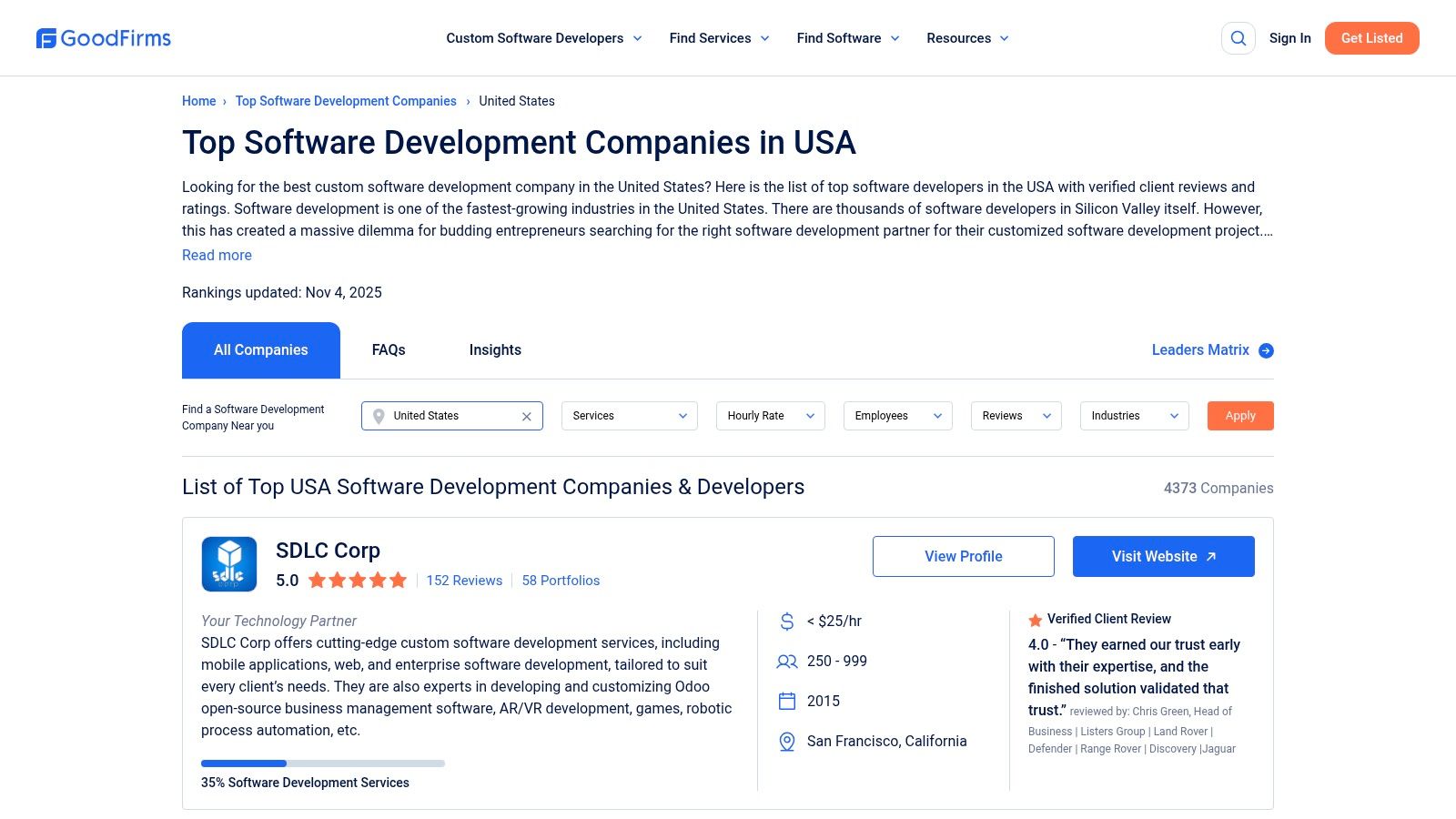
Why It Stands Out
GoodFirms stands out with its detailed, frequently updated Leaders Matrix and its robust directories, particularly for US-based providers. The platform allows users to easily compare firms by hourly rates, team size, and industry focus. This makes it simple to create a shortlist of potential partners who meet both budgetary and technical criteria.
The Leaders Matrix provides a visual snapshot of top-performing companies, ranked according to their market presence and client satisfaction. This, combined with detailed company profiles featuring portfolios and service focus breakdowns, gives businesses the data needed to make an informed decision for their custom software development needs.
How to Use GoodFirms Effectively
To maximize your search on GoodFirms, consider the following steps:
- Start with Broad Filters: Begin by filtering for your desired service and location, such as “Top Software Development Companies in the US.”
- Refine with Specifics: Drill down further using filters for hourly rate (e.g., “$50 – $99/hr”) and industry focus (e.g., “healthcare software development“).
- Analyze Company Profiles: Once you have a shortlist, dive into individual profiles. Pay close attention to the portfolio, verified reviews, and the “Services” tab to ensure their capabilities align with your goals.
- Leverage the Leaders Matrix: Use the Leaders Matrix for your specific service category to quickly identify recognized market leaders and see how they compare against others. This can help you find a capable AI solutions partner.
Pros and Cons
| Pros | Cons |
|---|---|
| Broad Coverage of US Providers: Extensive directory of US-based firms, making it easy to find local or nearshore partners. | Sponsored Placements Possible: Top rankings can sometimes be influenced by sponsorships, so it’s important to evaluate all listed companies. |
| Easy Comparison: Straightforward filters for price bands and industries allow for quick and effective vendor comparisons. | Direct Negotiation Required: GoodFirms is a directory, not a managed marketplace; you must handle all contract and pricing negotiations directly. |
| Useful Shortlisting Tools: Helps create targeted lists for specific technologies, cities, or project types. | Review Verification: While most reviews are vetted, it’s still wise to cross-reference claims with case studies or direct client references. |
Website: https://www.goodfirms.co/directory/country/top-software-development-companies/us
7. DesignRush
DesignRush is an agency directory and matchmaking platform designed to simplify the vendor selection process. For businesses that prefer a more guided approach to finding the best custom software development companies, it offers a free advisory service that connects them with a curated shortlist of vetted partners. This hands-on curation is ideal for decision-makers who want to quickly identify firms that match their specific budget, timeline, and project scope.
The platform streamlines the initial discovery phase by allowing users to submit a project brief. Based on this brief, DesignRush’s team provides a shortlist of three to five pre-qualified agencies, saving valuable time and effort. This marketplace workflow is a key differentiator, moving beyond a simple directory to offer a personalized matchmaking experience for services ranging from SaaS Consulting to complex enterprise software builds.

Why It Stands Out
DesignRush’s primary advantage is its no-cost advisory service, which acts as a concierge for vendor discovery. Instead of spending hours sifting through thousands of profiles, you get a human-curated list delivered directly to you. This is particularly helpful for companies new to outsourcing or those with limited resources for an extensive vetting process.
Its agency profiles are also transparent, often including indicative hourly rates, minimum project sizes, client reviews, and detailed portfolios. This upfront information helps businesses quickly assess if a potential partner aligns with their financial and technical requirements for a custom software development engagement.
How to Use DesignRush Effectively
To maximize your experience on the platform, consider these steps:
- Be Detailed in Your Project Brief: The quality of your curated shortlist depends on the quality of your submission. Clearly outline your technology stack, project goals, industry, budget constraints, and desired timeline.
- Explore the Directory Manually: While the matchmaking service is excellent, you can also browse the extensive directory of over 30,000 agencies. Use filters for services, location, and industry to find specialists, such as firms with deep expertise in IoT software development services.
- Review Agency Portfolios: Look beyond the listed services and dive into the agency’s portfolio and case studies. This will give you a better sense of their design aesthetic, technical capabilities, and the results they have delivered for past clients.
- Conduct Your Own Vetting: Use the DesignRush shortlist as a starting point. Always schedule introductory calls and conduct your own due diligence to ensure the agency is the right cultural and technical fit.
Pros and Cons
| Pros | Cons |
|---|---|
| No-Cost Matchmaking Service: Saves significant time and effort in the initial vendor discovery and shortlisting process. | Sponsored Placements: Some rankings and list placements may be editorially selected or influenced by sponsorships, so independent verification is key. |
| Transparent Agency Profiles: Clear information on hourly rates, project minimums, and service focus helps in quick evaluation. | Not an End-to-End Platform: DesignRush facilitates the introduction, but you must negotiate and manage contracts directly with the agency. |
| Large and Diverse Directory: Access to a vast pool of over 30,000 global and US-based agencies across various specializations. | Curation Varies: The quality of the match depends heavily on the detail provided in the initial project brief. |
Website: https://www.designrush.com/marketplace/software-development
Top 7 Custom Software Development Companies Comparison
| Service | Implementation complexity | Resource requirements | Expected outcomes | Ideal use cases | Key advantages |
|---|---|---|---|---|---|
| Bridge Global | Moderate–high — full lifecycle AI integration and enterprise delivery | Cross-functional offshore teams, discovery workshops, data readiness; moderate–high investment | Production-ready AI features, automated workflows, improved QA, faster time-to-market | Enterprise AI productization, compliant health tech, scaling SaaS, long-term modernization | End-to-end AI across SDLC, industry compliance expertise, proven client engagements |
| Clutch | Low — directory-based vendor discovery | Time to search, filter, and evaluate vendor profiles and reviews | Shortlisted vendors with verified client reviews and profile data | Shortlisting agencies by budget, tech stack, and location | Granular filters, transparent reviews, Leaders Matrix rankings |
| Upwork | Low–moderate — platform hiring with client-managed oversight | Individual freelancers or small teams, variable hourly/milestone budgets, platform fees | Rapid staffing, flexible hourly or milestone engagements | Short-term hires, prototyping, augmenting teams quickly | Very large talent pool, escrow/time-tracking protections, flexible pricing |
| Toptal | Low — white-glove matchmaking; minimal client-side process | Premium talent (higher rates), possible managed teams, two-week trial option | High-quality, vetted hires and reduced hiring risk via trial | Mission-critical projects requiring senior engineers or managed teams | Rigorous screening, fast hand-selected matches, risk-reducing trial |
| Fiverr (Pro) | Low for scoped gigs; moderate for complex projects needing coordination | Per-project budgets, Pro tier for vetted freelancers and curated teams | Fast delivery for discrete tasks; upfront pricing and delivery estimates | Small-to-mid builds, MVP modules, defined scoped work | Transparent per-project pricing, Pro vetting and hiring support |
| GoodFirms | Low — research and comparison platform | Time to review profiles, ratings, and rankings; negotiate directly with agencies | Broader shortlist of agencies with structured rankings and reviews | Discovering US/global agencies, comparing hourly bands and industries | Wide coverage, Leaders Matrix, industry and price-band filtering |
| DesignRush | Low — curated matchmaking service | Submit brief to receive 3–5 agency shortlists; evaluate proposals and negotiate | Fast, human-curated shortlists matched to budget and timeline | Buyers who want free advisory and quick curated vendor options | Free matchmaking, curated shortlists, transparent profile indicators |
Making Your Final Decision: Partnering for Success
Navigating the landscape of custom software development partners can feel overwhelming, but this guide has equipped you with a clear roadmap. We’ve explored a diverse range of options, from premier development firms like Bridge Global to expansive marketplaces and review platforms such as Clutch, GoodFirms, and DesignRush. Each platform serves a distinct purpose, whether you need a fully managed team for a complex enterprise project or a specialized freelancer for a niche task.
The journey from a powerful idea to a market-ready product is a strategic one, built on the foundation of the right technical partnership. Your final choice should not just be about finding coders; it’s about securing a partner who understands your business vision, aligns with your operational style, and possesses the proven expertise to turn ambitious goals into tangible results.
Key Takeaways and Actionable Next Steps
To distill this information into a clear action plan, focus on a methodical approach to selection. Remember that finding one of the best custom software development companies is less about a single “best” option and more about the “best fit” for your unique context.
1. Define Your Project Scope and Requirements with Precision:
Before you even begin outreach, create a detailed project brief. This document is your most critical tool.
- Problem Statement: What business challenge are you solving?
- Core Features: List the “must-have” versus “nice-to-have” functionalities.
- Target Audience: Who are the end-users? What are their needs?
- Technical Stack: Do you have preferred technologies or existing systems for integration?
- Budget & Timeline: Define realistic financial constraints and delivery expectations.
2. Evaluate Potential Partners Holistically:
Use the platforms we’ve discussed to build a shortlist, but don’t stop at surface-level profiles. Dig deeper by assessing these crucial factors:
- Portfolio and Case Studies: Look for projects similar to yours in industry, complexity, or scale. Reviewing relevant client cases provides insight into a firm’s problem-solving capabilities.
- Communication and Process: How do they manage projects? What is their communication protocol? A transparent, agile methodology is often a sign of a mature development partner.
- Technical Expertise: Scrutinize their proficiency in the specific technologies you need, whether it’s specialized AI development services, cloud services, or IoT software development services.
- Cultural and Time Zone Alignment: A partner who understands your work culture and can overlap with your business hours will significantly reduce friction and improve collaboration.
3. Conduct Thorough Interviews and Reference Checks:
Your final selection phase should involve direct interaction. Prepare thoughtful questions that go beyond technical skills.
- Ask how they would approach a specific challenge from your project brief.
- Inquire about how they handle scope changes or unexpected roadblocks.
- Request to speak with past clients, particularly those from long-term engagements.
Selecting a partner for custom software development is a pivotal business decision. It’s an investment in your company’s future, impacting everything from operational efficiency to market competitiveness. By following a structured evaluation process and prioritizing a true partnership over a simple vendor relationship, you set the stage for a successful, transformative project.
Frequently Asked Questions (FAQ)
What is custom software development?
Custom software development is the process of designing, creating, deploying, and maintaining software for a specific set of users, functions, or organizations. Unlike off-the-shelf software, custom solutions are tailored to address a company’s unique needs and workflows, providing a competitive advantage through enhanced efficiency and scalability.
How much does it cost to build custom software?
The cost of custom software varies significantly based on project complexity, the technology stack, the size and location of the development team, and the project timeline. A simple application might cost between $25,000 and $75,000, while more complex enterprise-level software can easily exceed $250,000. It’s best to consult with development companies to get detailed quotes based on your specific requirements.
How do I choose the right custom software development company?
To choose the right company, start by defining your project requirements clearly. Then, research potential partners on platforms like Clutch or GoodFirms, paying close attention to their portfolio, client reviews, and industry expertise. Shortlist 3-5 companies, conduct thorough interviews to assess their technical skills and communication processes, and ask for client references. The best partner will align with both your technical needs and your business culture.
What are the benefits of custom software development?
The key benefits include:
- Tailored Solutions: The software is built to your exact specifications.
- Scalability: Custom software can grow and adapt as your business evolves.
- Competitive Advantage: Unique software can create efficiencies and features that competitors cannot easily replicate.
- Integration: It can be designed to integrate seamlessly with your existing systems.
- Ownership: You own the intellectual property and are not reliant on a third-party vendor’s roadmap.
Ready to move from evaluation to execution? As one of the best custom software development companies specializing in turning complex challenges into scalable software, Bridge Global is your ideal AI solutions partner. Let’s discuss your vision and build the future of your business together.
